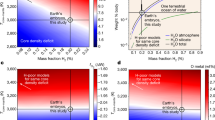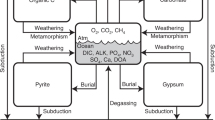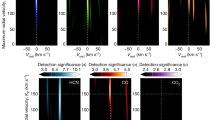Abstract
Nitrogen is a critical ingredient of complex biological molecules1. Molecular nitrogen, however, which was outgassed into the Earth’s early atmosphere2, is relatively chemically inert and nitrogen fixation into more chemically reactive compounds requires high temperatures. Possible mechanisms of nitrogen fixation include lightning, atmospheric shock heating by meteorites, and solar ultraviolet radiation3,4. Here we show that nitrogen fixation in the early terrestrial atmosphere can be explained by frequent and powerful coronal mass ejection events from the young Sun—so-called superflares. Using magnetohydrodynamic simulations constrained by Kepler Space Telescope observations, we find that successive superflare ejections produce shocks that accelerate energetic particles, which would have compressed the early Earth’s magnetosphere. The resulting extended polar cap openings provide pathways for energetic particles to penetrate into the atmosphere and, according to our atmospheric chemistry simulations, initiate reactions converting molecular nitrogen, carbon dioxide and methane to the potent greenhouse gas nitrous oxide as well as hydrogen cyanide, an essential compound for life. Furthermore, the destruction of N2, CO2 and CH4 suggests that these greenhouse gases cannot explain the stability of liquid water on the early Earth. Instead, we propose that the efficient formation of nitrous oxide could explain a warm early Earth.
This is a preview of subscription content, access via your institution
Access options
Subscribe to this journal
Receive 12 print issues and online access
$259.00 per year
only $21.58 per issue
Buy this article
- Purchase on Springer Link
- Instant access to full article PDF
Prices may be subject to local taxes which are calculated during checkout




Similar content being viewed by others
References
Barrett, G. C. & Elmore, D. T. Amino Acids and Peptides (Cambridge Univ. Press, 1998).
Ringwood, A. E. Chemical composition of the terrestrial planets. Geochim. Cosmochim. Acta 30, 41–104 (1996).
Summers, D. P., Basa, R. C. B., Khare, B. & Rodoni, D. Abiotic nitrogen fixation on terrestrial planets: reduction of NO to ammonia by FeS. Astrobiology 12, 107–114 (2012).
Kasting, J. F. Bolide impacts and the oxidation state of carbon in the Earth’s early atmosphere. Orig. Life Evol. Biosph. 20, 199–231 (1990).
Maehara, H. et al. Superflares on solar-type stars. Nature 485, 478–481 (2012).
Shibayama, T. et al. Superflares on solar-type stars observed with Kepler. I. Statistical properties of superflares. Astrophys. J. Suppl. Ser. 209, 5 (2013).
Gopalswamy, N. et al. Properties of ground level enhancement events and the associated solar eruptions during solar cycle 23. Space Sci. Rev. 171, 23–60 (2012).
Tsurutani, B. T., Smith, E. J., Pyle, K. R. & Simpson, J. A. Energetic protons accelerated at corotating shocks - Pioneer 10 and 11 observations from 1 to 6 AU. J. Geophys. Res. 87, 7389–7404 (1982).
Emslie, A. G. et al. Global energetics of thirty-eight large solar eruptive events. Astrophys. J. 759, 71 (2012).
Miyake, F., Nagaya, K., Masuda, K. & Nakamura, T. A signature of cosmic-ray increase in AD 774–775 from tree rings in Japan. Nature 486, 240–242 (2012).
Miyake, F., Masuda, K. & Nakamura, T. Another rapid event in the carbon-14 content of tree rings. Nature Commun. 4, 1748 (2013).
Tsurutani, B. T., Gonzales, W. D., Lakhina, G. S. & Alex, S. The extreme magnetic storm of 1–2 September 1859. J. Geophys. Res. 108, 1268 (2003).
Vidotto, A. A. et al. Stellar magnetism: empirical trends with age and rotation. Month. Not. R. Astron. Soc. 441, 2361–2374 (2014).
Airapetian, V., Glocer, A. & Danchi, W. in Proc. 18th Cambridge Workshop on Cool Stars, Stellar Systems, and the Sun (eds van Belle, G. & Harris, H.) 257–268 (2015).
Airapetian, V. S. & Usmanov, A. V. Reconstructing the solar wind from its early history to current epoch. Astrophys. J. 817, L24–L30 (2016).
Tarduno, J., Blackman, E. G. & Mamajek, E. E. Detecting the oldest geodynamo and attendant shielding from the solar wind: implications for habitability. Phys. Earth Planet. Inter. 233, 68–87 (2014).
Liu, Y. D. et al. Observations of an extreme storm in interplanetary space caused by successive coronal mass ejections. Nature Commun. 5, 3481 (2014).
Gronoff, G. et al. The precipitation of keV energetic oxygen ions at Mars and their effects during the comet Siding Spring approach. Geophys. Res. Lett. 41, 4844–4850 (2014).
Cnossen, I. et al. Habitat of early life: solar X-ray and UV radiation at Earth’s surface 4–3.5 billion years ago. J. Geophys. Res. 112, E02008 (2007).
Claire, M. W. et al. The evolution of solar flux from 0.1 nm to 160 μm: quantitative estimates for planetary studies. Astrophys. J. 757, 95 (2012).
Mewaldt, R. A. Energy spectra, composition, and other properties of ground-level events during solar cycle 23. Space Sci. Rev. 171, 97–120 (2012).
Goldblatt, C. et al. Nitrogen-enhanced greenhouse warming on early Earth. Nature Geosci. 2, 891–896 (2009).
Nna-Mvondo, D., Navarro-González, R., Raulin, F. & Coll, P. Nitrogen fixation by corona discharge on the early precambrian Earth. 2005. Orig. Life Evol. Biosph. 35, 401–409 (2005).
Brandvold, D. K., Martinez, P. & Hipsh, R. Field measurements of O3 and N2O produced from a corona discharge. Atmos. Environ. 30, 973–976 (1996).
Gough, D. O. Solar interior structure and luminosity variations. Solar Phys. 74, 21–34 (1981).
Kasting, J. F. Early Earth: faint young Sun redux. Nature 464, 687–689 (2010).
Wordsworth, R. & Pierrehumbert, R. Hydrogen–nitrogen greenhouse warming in Earth’s early atmosphere. Science 339, 64–67 (2013).
Rosing, M. T., Bird, D. K., Sleep, N. H. & Bjerrum, C. J. No climate paradox under the faint early Sun. Nature 464, 744–747 (2010).
Miyakawa, S., Cleaves, H. J. & Miller, S. L. The cold origin of life: B. implications based on pyrimidines and purines produced from frozen ammonium cyanide solutions. Orig. Life Evol. Biosph. 32, 209–218 (2002).
Powell, K. G., Roe, P. L., Linde, T. J., Gombosi, T. I. & De Zeeuw, D. L. A solution-adaptive upwind scheme for ideal magnetohydrodynamics. J. Comp. Phys. 154, 284–309 (1999).
de Zeeuw, D. L. et al. Coupling of a global MHD code and an inner magnetospheric model: initial results. J. Geophys. Res. 109, A12219 (2004).
Ridley, A. J. et al. University of Michigan MHD results of the geospace global circulation model metrics challenge. J. Geophys. Res. 107, 1290 (2002).
Ngwira, C. M., Pulkkinen, A., Kuznetsova, M. M. & Glocer, A. Modeling extreme “Carrington-type” space weather events using three-dimensional global MHD simulations. J. Geophys. Res. 119, 4456–4474 (2014).
Acknowledgements
This work was supported by NASA GSFC Science Task Group funds. V.S.A. performed the part of this work while staying at ELSI/Tokyo Tech. G.G. was supported by NASA Astrobiology Institute grant NNX15AE05G and by the NASA HIDEE Program, E.H. was supported by an appointment to the NASA Postdoctoral Program at NASA Goddard Space Flight Center, administered by Universities Space Research Association through a contract with NASA.
Author information
Authors and Affiliations
Contributions
V.S.A. conceived and designed the numerical experiments, analysed the data, contributed materials and wrote the manuscript. A.G. and G.G. contributed to the development and execution of codes and data analysis. E.H. contributed to the chemistry model and data analysis, W.D. contributed to development of the manuscript, to data analysis and proofreading of the paper.
Corresponding author
Ethics declarations
Competing interests
The authors declare no competing financial interests.
Supplementary information
Supplementary Information
Supplementary Information (PDF 529 kb)
Supplementary Information
Supplementary Information (MPG 2360 kb)
Rights and permissions
About this article
Cite this article
Airapetian, V., Glocer, A., Gronoff, G. et al. Prebiotic chemistry and atmospheric warming of early Earth by an active young Sun. Nature Geosci 9, 452–455 (2016). https://doi.org/10.1038/ngeo2719
Received:
Accepted:
Published:
Issue Date:
DOI: https://doi.org/10.1038/ngeo2719
This article is cited by
-
Miller’s spark
Nature Reviews Chemistry (2023)
-
Magma Ocean, Water, and the Early Atmosphere of Venus
Space Science Reviews (2023)
-
Understanding planetary context to enable life detection on exoplanets and test the Copernican principle
Nature Astronomy (2022)
-
Mineral-catalysed formation of marine NO and N2O on the anoxic early Earth
Nature Geoscience (2022)
-
The Exosphere as a Boundary: Origin and Evolution of Airless Bodies in the Inner Solar System and Beyond Including Planets with Silicate Atmospheres
Space Science Reviews (2022)



